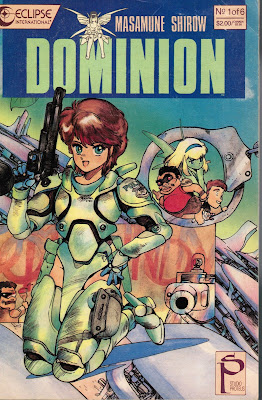I’m not deeply knowledgeable about the early career of Osamu Tezuka, but I’ve the impression that even in the 1940s—a time when American comic books were dominated by standalone short stories—Tezuka utilized in many of his works multi-part stories, often comprising the different types of arcs I’ve detailed here. For that reason, many manga-serials started off constructing stories in these more expansive forms.
On the other hand, in some cases appearances may prove deceiving. Masamune Shirow’s DOMINION serial first appeared in six stories published in 1985, and at a quick glance one might think that all six stories might comprise a unified arc. In truth, though, these six issues are comprised of one two-part short story, two more short stories, and then a final two-parter. Though the tales all share the same characters and concerns, some could be easily read apart from the others, just like any commonplace American comic. This situation is rather ironic, if it’s true that Shirow derived one aspect of this series from the American teleseries HILL STREET BLUES, a cop show that popularized mainstream television’s use of intersecting short-arc storylines.
Over time Shirow has shown himself to be exemplary in terms of sheer creativity, but less so in terms of plotting and characterization, seeming at times to be a disciple of the “throw stuff against the wall and see what sticks” school. The last two-parter in the six-issue series is particularly incoherent, but the first two-part tale, which I’ve entitled “the Greenpeace Plan,” shows impressive mythicity-potential.
It's a dystopian far-future—albeit one played for comedy—wherein much if not all of Earth suffers from serious pollution. Most citizens won’t even emerge from their homes without wearing masks—making DOMINION eerily prescient to current times—and citizens are forever making frivolous complaints to the cops of Newport City. (This may be Shirow’s version of New York if the HILL STREET parallel holds; at very least it’s established that lead character Leona Ozaki is the only Japanese, so it’s not a future-Japan this time.) Leona belongs to the city’s Tank Police Corps, which means that she and her sidekick-driver Al pilot a small-sized super-tank through the city-streets. Though opposed to all crime, the Tank Police are primarily focused on the gang of one super-crook, the portly Buaku.
All of the cops in Leona’s department are lovable goofballs, and Leona herself is no exception, in that she has a quasi-erotic fixation on her mini-tank, whom she names “Bonaparte” (because it's small but powerful, maybe?) Her nemesis Buaku is first seen robbing a bank, looking like a robber from a silent comedy, and he gets away easily, mocking the police. Later, a tip leads the officers to one of Buaku’s hideouts. They don’t find the gang-leader or his gang, but they find a green-skinned android girl with butterfly-like wings mounted on her back. Someone or other gives the android the name “Greenpeace Crolis,” and the department’s resident science-guy figures out that she’s a “living air cleaner,” capable of recycling the world’s polluted air and producing fresh atmosphere—though of course she’s not big enough to change the reigning ecosystem.
In the second part of “Greenpeace,” Leona’s life gets more complicated when a citizens’ group uses political leverage to get the Tank Police to foreswear their dangerous “toy tanks” and to use instead a new form of tank, equipped with climbing-tentacles. Leona resents this prohibition, but curiosity leads her to investigate the new model. By so doing, she stumbles onto a Big Secret. Super-crook Buaku has manipulated the citizens’ committee into making a new tank so that he can steal it for his own use. As part of his overall plan, he also uses his henchmen to steal back the android Greenpeace.
Buaku captures Leona and goes through the standard “let me tell you my evil plan” routine. The villain claims that the original purpose of the android’s creators was “the Greenpeace Plan,” which would involve transforming all of Earth’s humans into “people who can breathe” the crappy Earth atmosphere. Buaku wants to live on a virgin, unspoiled world, and later in the continuity it turns out that he apparently plans to steal an interstellar ship and take Greenpeace to another world. I say “apparently” because the villain’s plot never completely makes sense. Leona turns the tables on Buaku, and even uses her prized Bonaparte to defeat the rival tank under the crook’s control. Buaku is captured, though the second part ends with him being freed by his followers, implying that the zany duel of cops and robbers will go on unabated.
Toward the end of the two-parter, one cop recovers from being shot, and his comrade breaks the fourth wall by telling him, “If this was a serious comic, you’d be dead as a can of tuna, now.” Shirow comes up with some fascinating myth-concepts involving the ecosystem and humankind’s misuse of it. But it appears he wanted to keep things light for this series. The author didn’t craft many installments for DOMINION, and the next one even tosses out the pollution-angle, possibly because it was too much of a downer. His GHOST IN THE SHELL probably generated far more reader-enthusiasm, and thus resulted in a series of lucrative TV shows and videogames. I’ve read only one GHOST and I found it less challenging than GREENPEACE. However, at some point I may attempt to investigate Shirow’s repertoire in greater depth.





No comments:
Post a Comment